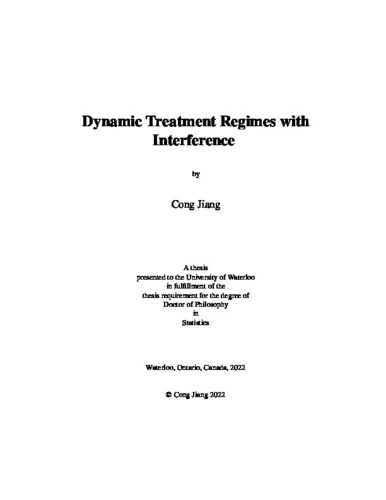| dc.description.abstract | Precision medicine describes healthcare in which patient-level data are used to inform treatment decisions. Within this framework, dynamic treatment regimes (DTRs) are sequences of decision rules that take individual patient information as input, and then output treatment recommendations. The primary purpose of DTR research is to estimate the optimal dynamic treatment regimes: the sequence of treatment rules that will optimize some pre-defined outcomes across a population. The focus of this thesis is on developing methods for estimating optimal DTRs in the presence of interference, where one patient’s outcome can be affected by others’ treatment. DTR estimation methods typically rely on the assumption of no interference. In many social network contexts, such as friendship or family networks, and for many health concerns, such as infectious diseases, this assumption is questionable. Moreover, the existing doubly robust regression-based DTR estimation methods are primarily focused on continuous outcomes. DTR estimation methods for binary or ordinal outcomes are more complicated due to less information being provided by these discrete outcomes. Consequently, very few DTR estimation methods focus on binary or ordinal outcomes, let alone methods when interference is present. To address these problems, for continuous outcomes, we directly establish novel interference-aware DTR estimation methods, and for binary or ordinal outcomes, we develop methods for DTR estimation first in cases without interference and then in ones affected by it.
This thesis contains three main components: (1) a doubly robust method to estimate the optimal DTRs for individuals where the treatments of their connected neighbours in the same social network are taken into account in the decision rules; (2) a doubly robust method to estimate the optimal DTRs for binary outcomes using sequential weighted generalized linear models; (3) a doubly robust method to estimate the optimal DTRs for ordinal outcomes in the presence of household interference. In (1), we study the DTR estimation method of dynamic weighted ordinary least squares (dWOLS), which boasts easy implementation and double robustness, but relies on the no interference assumption. We define a network propensity function and build on it to establish an implementation of dWOLS that remains doubly robust under interference associated with network links. The method's properties are shown via simulation and applied to household pairs data from the Population Assessment of Tobacco and Health (PATH) Study. On the basis of the theories of dWOLS and using our interference-aware version, we focus on developing innovative DTR estimation methods for both binary and ordinal outcomes, in particular, the methods in the presence of interference. In (2), considering binary outcomes, we propose a new method for DTR estimation without interference, the dynamic weighted generalized linear model (dWGLM), which accommodates binary outcomes while offering relatively straightforward implementation and robustness to model misspecification. We introduce the method and its underlying theory, and illustrate both in an analysis of e-cigarette usage and smoking cessation, using the observational data from the PATH study. Finally, in (3), we further extend these regression-based DTR methods to the ordinal outcome case, and also propose a robust method — the dynamic weighted proportional odds model (dWPOM). Moreover, in the presence of household interference, exploring the possible correlation between treatments in the same household, we investigate the covariate balancing weights, which rely on the joint propensity score, and methods for estimating the joint propensity score. Examining different types of balancing weights, we verify the double robustness of dWPOM with our adjusted weights via simulation studies. Lastly, we also illustrate dWPOM in the analysis of data from PATH. For each participant's household, we derive the household treatment configuration recommendations for achieving the best outcome of the pair: both individuals quit or attempt to quit smoking. | en |

